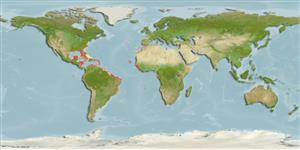Common names from other countries
Environment: milieu / climate zone / depth range / distribution range
Ecologia
Associadas(os) a recifes; estuarina; intervalo de profundidade 1 - 23 m (Ref. 108813). Tropical
Atlantic Ocean.
Length at first maturity / Tamanho / Peso / Idade
Maturity: Lm ? range ? - ? cm Max length : 15.0 cm H macho/indeterminado; (Ref. 415)
Clusters of hollow tubes, ramose solid branches: 0.5 - 2 cm thickness; up to 15 cm high, ; or cushions, 1 - 3 cm thick. Oscula on side of branches or on top of hollow tubes: 0.2 - 0.5 cm wide. Bright pink to brownish externally, lighter to tan internally. Soft and limp in consistency. Surface microhispid (Ref. 415).
On mangrove habitat, and under coral rubble (Ref. 415).
Life cycle and mating behavior
Maturidade | Reprodução | Desova | Ovos | Fecundidade | Larvas
Members of the class Demospongiae are hermaphroditic. Life cycle: The zygote develops into parenchymella larva (free-swimming) before settling down on a substrate where it grows into a young sponge.
Collin, R., M.C. Díaz, J. Norenburg, R.M. Rocha, J.A. Sánchez, M. Schulze, A. Schwartz and A. Valdés. 2005. (Ref. 415)
Status na Lista Vermelha da IUCN (Ref. 130435)
Status no CITES (Ref. 108899)
Not Evaluated
Not Evaluated
Perigo para os humanos
Harmless
Uso pelos humanos
| FishSource |
Ferramentas
Fontes da internet
Estimates based on models
Preferred temperature
(Ref.
115969): 19.9 - 28.1, mean 27.1 (based on 932 cells).
Vulnerabilidade
Low vulnerability (10 of 100).
Categoria de preço
Unknown.
